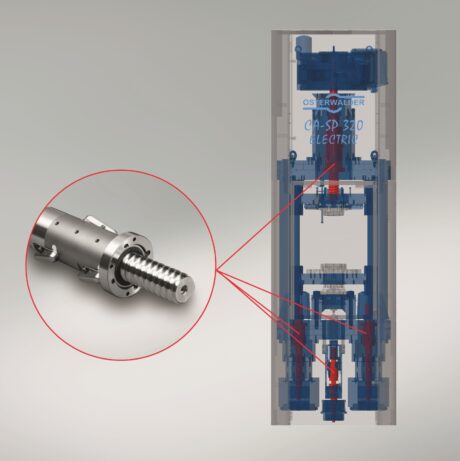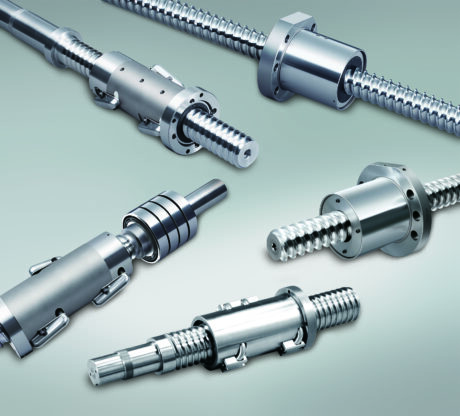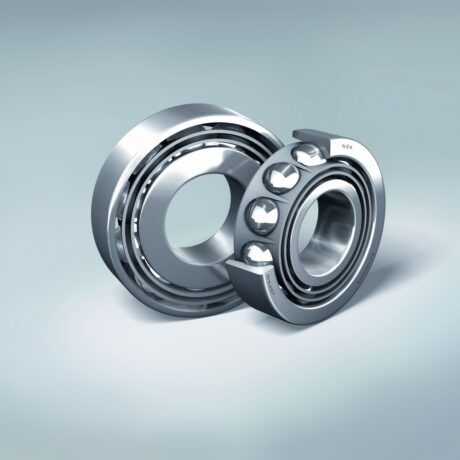S-HTF series ball screws from NSK are for the first time enabling leading powder-press manufacturer Osterwalder AG

S-HTF series ball screws from NSK are for the first time enabling leading powder-press manufacturer Osterwalder AG to employ servo-electric drives on its larger machines, rather than conventional hydraulic drives. As a result, new systems such as the Osterwalder OPP 2000 multi-level machine with 2,000 kN press force, use around 80% less energy than hydraulic counterparts of equivalent power output. In addition, pressed parts are produced with significantly higher dimensional accuracy, which reduces the amount of reworking and substantially lowers process and material costs.

Based in Lyss, Switzerland, Osterwalder can call upon 130 years of engineering innovation. The company´s powder presses are used for an increasing number of applications worldwide, including gears for automotive transmissions and metalworking tools such as drill bits and indexable machining inserts, all of which can be manufactured in high quantities. In the pressing process, a fine metal powder alloy is poured into a die and shaped under pressure. Subsequently, the “green body” – as the intermediate product is called – is sintered to achieve the desired properties with regard to hardness, wear resistance and contour precision.
Technology step change
Today, Osterwalder offers a wide range of machines, and with the CA-SP Electric and CA-HM Electric powder press series introduced around five years ago, brought to market a completely new type of drive technology. Direct Drive Technology (DDT), as it is known, comprises servo-electric motors and NSK ball screws, and thus replaced the hitherto dominant hydraulic drives in this field of application.
Thanks to DDT, the pressing process now offers much greater precision, as electric displacement measurement variables and adjustment criteria are easier to define and program than when using hydraulic drives. In addition, ball screws offer greater stiffness than hydraulic cylinders, which display substantial displacement due to the compressibility of the fluid media. The workpieces produced by servo-electric powder presses are thus more homogeneous and their material properties can be adjusted with greater precision.
Initially, Osterwalder AG was using ball screws from the NSK HTF series in the servo-electric direct drives of the CA-SP Electric and CA-HM Electric series. These ball screws allow very high traversing speeds combined with greater precision and stiffness. At the same time, each unit enables extremely high axial forces to be transferred, and the wear is minimal even under high load and fast cycle conditions. Three seconds is a typical powder-press cycle time.
Moving from HTF to S-HTF
The DDT drive principle has proven itself over the past five years, initially for press forces up to 160 kN, and then up to 640 kN. As a result, it was only logical for Osterwalder to take the next step and equip its larger presses with this drive technology. However, the HTF series from NSK and comparable ball screws from other manufacturers reach their limits here with regard to nominal service life.
As part of its ongoing development programme, NSK had in the meantime developed its S-HTF ball screw series, which would prove extremely timely for Osterwalder. S-HTF ball screws offer a higher dynamic load capacity with the same dimensions, thus delivering a service life that is significantly extended.

These performance attributes are made possible by using proprietary NSK material that is not only capable of withstanding high loads, but thanks to special heat treatment, provides an optimised balance between hardness and toughness. The use of this TF (Tough Force) material ensures, among other things, that hard impurities in the raceway do not cause indentations or projections, but are instead smoothed out after repeated over-rolling.
Endurance tests performed in the NSK laboratory showed that the TF technology used in the ball screws of the S-HTF series results in triple the service life, as well as a 30% higher dynamic load capacity in comparison with the HTF series, which already offered very high values against competitor ball screws.

World premiere for new powder press
Taking advantage of the S-HTF ball screw, Osterwalder has recently given a world premiere to its OPP 2000, the company´s first servo-electric multi-level powder press with a pressing force of 2,000 kN.
Product manager and team leader construction, Michael Sollberger, says: «We can now realise the excellent dynamic movement control offered by a servo-electric drive in the higher power range – and meet the requirements of customers for the production of more complex geometries with a very high degree of accuracy. We are able to achieve positioning accuracy of 1 µm and travel through specified movement profiles. This significantly improves product quality and minimises the need for rework from the user´s perspective.»
According to Osterwalder, the new multi-level press is ideal for the cost-effective production of a wide range of products, including engine components, parts for electric tools and kitchen utensils, as well as carbide rods. Aside from the aforementioned advantages, the user also profits from significantly reduced maintenance requirements and a compact press footprint. Moreover, the energy consumption of the company´s larger presses, such as the OPP 2000, is only about 20% of that required by hydraulic presses, depending on the part to be pressed. For the press user, this saving is a compelling argument, as the typical Osterwalder customer operates up to 50 powder presses.
Drive for manufacturing innovation
Ultimately, the advances made by Osterwalder highlight that innovations in drive systems can lead to developmental leaps in manufacturing technology.
As a point of note, NSK also supplies Osterwalder with the rolling bearings required for the axial support of S-HTF ball screws. Angular-contact thrust ball bearings of the TAC series are the bearings of choice. These bearings were developed specifically for this application and, especially with regard to precision machines, are usually installed as complete system units for axial support and linear movement.



